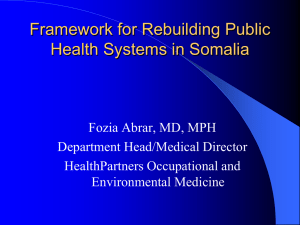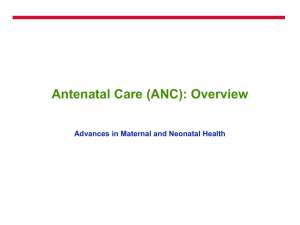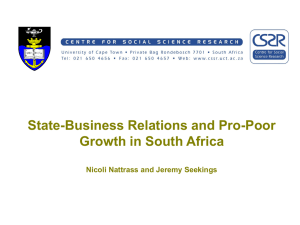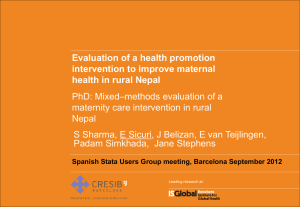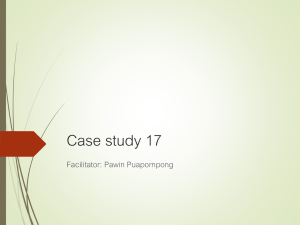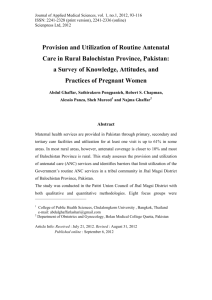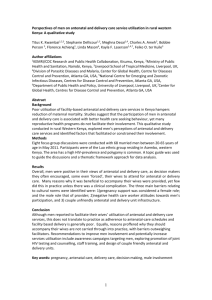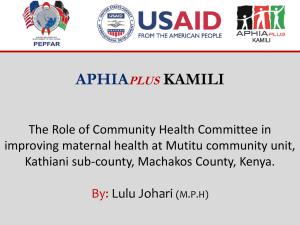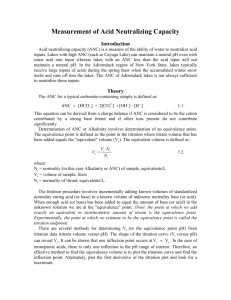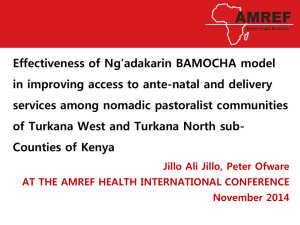Utilization of Antenatal Care Services at Yala Sub
advertisement
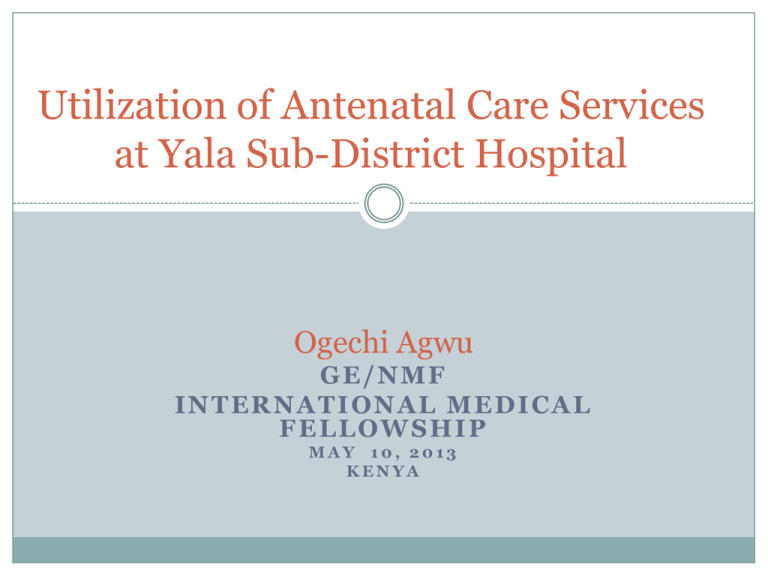
Utilization of Antenatal Care Services at Yala Sub-District Hospital Ogechi Agwu GE/NMF INTERNATIONAL MEDICAL FELLOWSHIP MAY 10, 2013 KENYA Agenda Introduction • • • Maternal Mortality and Maternal Health Initiatives Antenatal Care Yala Sub-District Hospital MCH Services Research Objectives Methods Results Discussion Conclusion Executive Summary This is a hospital-based study using a questionnaire to assess the utilization of antenatal care services at YSDH’s Maternal and Child Health Clinic. Information collected includes: demographics of women presenting for antenatal care, gestational age and gravidity at presentation, awareness and promotion of services, levels of utilization of services, and opinion of services Perhaps the results of this study can offer incite into possible deficiencies in antenatal care service delivery and provide further strategies for addressing the problem of maternal mortality in Kenya. Maternal Mortality Maternal & Perinatal Health is central to global well-being Causes of Maternal Mortality Maternal Mortality Other Indirect 18% Death of a woman while pregnant or within 42 days of termination of pregnancy = Global health problem Other Direct 11% Embolism 1% Unsafe abortion 9% Hemorrhage 35% Hypertension 18% Sepsis 8% Maternal Mortality: World vs Africa Source: Trends in Maternal Mortality 1990-2010. WHO, UNICEF, UNFPA and The World Bank. Maternal Mortality: Kenya Source: WHO, UNICEF, UNFPA, The World Bank and UN Population Division of Maternal Mortality Estimation Inter-Agency Group Maternal Health Initiatives UN Millennium Development Goal 5 Improve Maternal Health US Government-Kenya Partnership (GHI Strategy) Reduction of maternal, neonatal and child mortality Kenya Maternal mortality reduction Uhuru Vision 2030 Kenyatta Maternity fee waiver Antenatal Care As the major causes of maternal mortality are preventable, Antenatal care (ANC) has been targeted as a potential prevention strategy. Important gateway for overall Women’s health Focused ANC: evidence-based approach recommended for low-risk pregnancies 4 intervention-focused visits (one within first trimester) syphilis serologic screening malaria prevention education and provisions anti-tetanus immunization (TT) prevention of mother-to-child transmission of HIV (PMTCT) Goals: Emergency preparedness (early detection and treatment) Birth preparedness Health promotion YSDH Maternal & Child Health Services Fetal monitoring Testing (e.g. BP, Antenatal profile, HIV, malaria) Medications (e.g. Malaria ppx, Iron, ARVs) Vaccinations (e.g. TT) ITNs Education (e.g. PMTCT) Research Objectives • Determine whether ANC is being promoted • Assess for utilization of ANC services as per WHO recommendations (FANC) • Assess whether gravidity affects utilization of ANC Methods 20-question survey (YES/NO and open-ended questions) April 10 – 18th, 2013 MCH Clinic peak hours (9 am – 1pm) CHW served as translator (Kiswahili and Luo) SAMPLE SURVEY Results Demographics of cohort (n=38) Age (years) ≤19 6 (16%) 20-34 28 (74%) ≥35 4 (11%) Marital status Married 30 (79%) Single 8 (21%) Gestational age (months) unknown 1 (3%) 0-3 1 (3%) 4-6 13 (34%) 7-9 23 (60%) Gravidity G1 7 (18%) G2-G4 25 (66%) G5+ 6 (16%) Results (cont’d) ANC promotion 76% aware of ANC prior to becoming pregnant Majority (45%) of women were informed about ANC by a Non-pregnant friends/family member 24% credited school/media/self;16% reported skilled health professional/pregnant friend or family member ANC utilization 18% presented for first ANC visit 71% presenting at GA ≥ 5 months 82% had completed 2 or more ANC visits 82% report full utilization Results (cont’d) ANC utilization: malaria interventions vs anemia interventions Malaria tested? Take iron? 50% 21% 79% 50% Sleep with mosquito net? 5% 95% Deworming meds taken? 32% 26% 42% Results (cont’d) G1 vs G2+ levels of utilization First ANC visits: 43% of G1s vs 13% G2+ 2 or more ANC visits: 57% of G1s, 87% of G2+ Opinion of services 95% rated services as “Very important” 92% rated services as “Good, would not change anything” Discussion ANC promotion Majority of the women were aware of ANC prior to becoming pregnant Based on awareness, mothers tended to be the biggest promoters of ANC ANC utilization Majority of the women had completed 2 or more visits Majority of those presenting for the first visit presented far into pregnancy Women tended not to miss appointments; tend to adhere to recommendations Gravidity Majority of the women (both the primigravids and multigravids) had completed at least 2 ANC visits Conclusion Women are aware of ANC services prior to becoming pregnant but do not present for care until late in second trimester. While women tend to present late in second trimester, they are compliant with given recommendations. There is no gross difference in levels of utilization of ANC between multigravids and primigravids. The most common ANC service women are aware of is HIV testing. Women are generally not being instructed about warning signs of pregnancy complications 68% reported not having been instructed about warning signs Limitations 92% reported being tested , 21% reported taking ARVs Language barrier makes open-ended responses harder to assess. Education level and plans for delivery/delivery location were not assessed. Future research considerations: When are women aware of their pregnancy status? Why are women not seeking ANC in the first trimester? What is the level of utilization of ANC services for women who plan to deliver at home? Why are warning signs of pregnancy complications not being addressed during ANC visits? Acknowledgement GE/NMF Special Thanks: Dr Awino, Dr. Momanye, Mr. Opere Hassan O. Ramadhan Dr. Odero, Dr. Onyango, Dr. Wagude Dr. Omoto Dr. Anyona, Brian (CDC/KEMRI at SDH) Survey participants and CHWs at the MCH in YSDH References Kenya National Bureau of Statistics and ICF Macro. 2010. 2008-09 Kenya Demographic and Health Survey. Calverton, Maryland: KNBS and ICF Macro. Ministry of Public Health and Sanitation and Ministry of Medical Services, GOK. 2011. Global Health Initiative Kenya Strategy (2011-2014). Nairobi, Kenya: MOH. GOK. 2007. Kenya Vision 2030: A Globally Competitive and Prosperous Kenya. Nairobi, Kenya: Ministry of Planning and National Development and the National Economic and Social Council (NESC). National Coordinating Agency for Population and Development. 2010. Policy Brief No. 9, Maternal Deaths on the Rise in Kenya: A Call to Save Women’s Lives. Nairobi, Kenya: NCAPD. WHO/UNDP/UNICEF/UNFPA/World Bank. Mother-Baby Package: Implementing Safe Motherhood in Countries. Geneva: World Health Organization, 1994 Ouma PO, van Eijk AM, Hamel MJ, Sikuku ES, et al. Antenatal and delivery care in rural western Kenya: the effect of training health care workers to provided “focused antenatal care.” Reproductive Health 2010, 7:1

